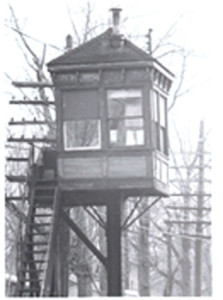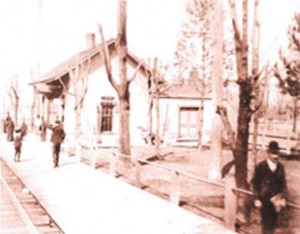Running through the middle of Irvington and extending to the east towards Cumberland is a ribbon of asphalt that walkers and bikers now enjoy as the “Pennsy Trail.” While today many find this serene byway a respite from daily life, for nearly 130 years a silver ribbon of steel rail spanned this space with the frequent rumbling of cars pulled by giant engines belching smoke and steam and later pulled by sleek Diesels.
My attachment to this railway begins with my great-grandfather who was the yardmaster in Cambridge City, Indiana. After his death in a railroad accident in Greenfield, Indiana, my grandfather began his career with the railroad. He was an engineer and came to live in Irvington in 1927 to work at Hawthorne Yards. My mother road along these rails when she came to Indianapolis as a newlywed, and these rails took my father away to the U. S. Navy in World War II and returned him safely at the end of the war. Finally, one of my cousins was the engineer who took the last train along this railroad when Conrail abandoned the line.
The old Centerville Road, located a few blocks south of the National Road, provided a convenient pathway when it was decided to build a railroad to the east of Indianapolis extending to Richmond, Indiana. Survey work was completed on the proposed route across fields and meadows, through woodlands and towns by the early summer of 1851. Finally, in December 1853 the Indiana Central Railroad was fully operational along “the straightest Railroad line in the State.” In the following years with the laying of additional track in Ohio, the railroad became the Columbus & Indianapolis Central Railway.
Probably the most notable event in the long history of these rails occurred in the early morning hours of Sunday, April 30, 1865 when the train bearing the body of President Abraham Lincoln slowly made its way in the rain from Richmond to Indianapolis. The funeral train rolled through towns passing depots draped in black, church bells tolled, brass bands played mournful dirges, and mourners “reverently uncovered their heads.” Along the route choirs gathered chanting hymns, men, women, and children held solemn vigil, and large bonfires turned night into day.
This rail transportation corridor to and from Indianapolis became known as “the Panhandle” following the Civil War. Named for an early division of the Pittsburgh, Cincinnati, Chicago & St. Louis Railroad that crossed the panhandle of West Virginia, the Panhandle became a major railway serving the Hoosier capital. With this growth came the little squat gray brick railroad station in the new town of Irvington. The Irvington Station not only served as a railroad stop, but it was central to the community’s life. For many years, people got their mail at the depot; the waiting room was a gathering place for Irvington citizens to meet and vote. Daily, before street cars began running on Washington Street, businesspeople and shoppers would take the morning train downtown and return in the evening. Butler College students arrived at the station for the fall term and departed for the summer after finals. It was where families would wait in anticipation of a loved one’s arrival or pick up that special package. The Irvington Station closed in May 1922 and was subsequently razed. Today, the only visible reminder of the station is the mile marker on the east side of Audubon Rd. which originally stood between the double tracks in front of the station. The “183” is the mileage from Irvington to Columbus, Ohio.
Through various mergers, the rail line running through Irvington finally was acquired by the Pennsylvania Railroad in 1890. A second track was laid and as one train sped through Irvington heading towards Union Station, within minutes another train would be making the slow climb up the steep grade heading to points east from Indianapolis. In addition to freight service, the route became the Pennsylvania Railroad’s Blue Ribbon passenger line between New York City and St. Louis, Missouri with named trains “Spirit of St. Louis” and “Jeffersonian.” Luxurious travel was the hallmark of the Pennsylvania’s all-Pullman sleeper “Spirit of St. Louis” with lounge car, observation car, and dining cars. Following minutes after it, the all air conditioned coaches, featuring reclining seats, of the “Jeffersonian” with its lounge car, observation car, and dining cars sped down the silvery rails. People along the route could set their watches by the trains’ passage.
Once a common sight along the former right-of-way were steel poles supporting signal lights and signal flags, but today all that remains are concrete footings. A signal tower — a shed atop a massive steel beam — stood at Ritter Ave. where the signal man manually controlled the crossing lights at Emerson Ave, Ritter Ave, Audubon Rd., and Arlington Ave. The crossings were dangerous, and a number of lives were tragically lost over the years.
The 1950s and ‘60s were the twilight years of passenger rail service as commercial air travel became more convenient. The merger of the Pennsylvania Railroad with the New York Central Railroad – the Penn-Central – only forestalled the railroad’s demise. By the early 1970s the railroad was in bankruptcy, and the federal government created Amtrak for passenger train service and Conrail for freight train service. Amtrak replaced the “Spirit of St Louis” with the “National Limited,” but by the end of the decade the last passenger train rolled through Irvington. Conrail discontinued freight service along the old Panhandle route in Indiana and the track was abandoned in 1982.
Portions of the old Pennsylvania right-of-way were sold to adjoining land owners and the steep grade west of Ritter Ave. was filled in. After much talk, the Pennsy Trail slowly began to be laid out, first in Greenfield and Cumberland, and finally in Irvington. When the wind rustles the leaves in the trees and brush along the Trail, for a moment one can hear the lonesome whistle of an engine pulling the cars of commerce through an empty countryside.




